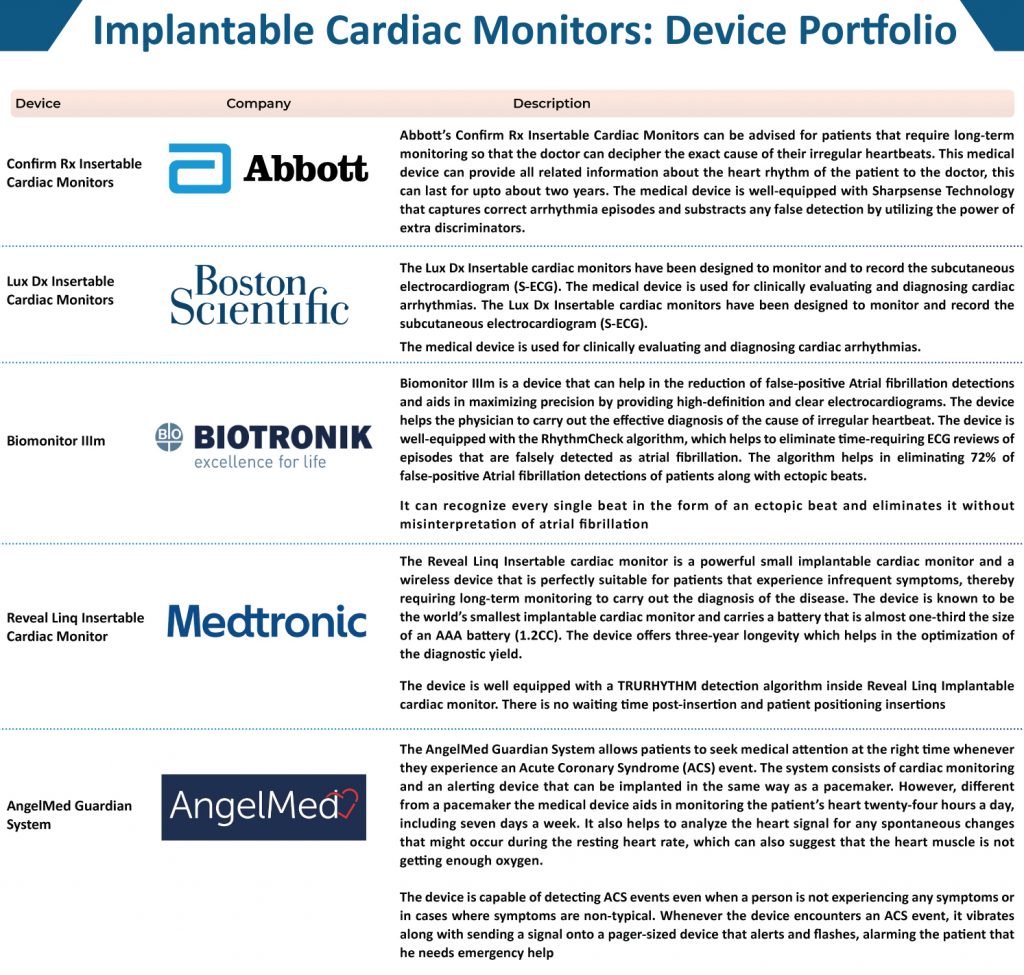What Factors are Shaping the Trends in the Implantable Cardiac Monitors Market?
Jun 25, 2021
Table of Contents
The Implantable Cardiac Monitors (ICM), also known as implantable loop recorders (ILR), are subcutaneous, single-lead, electrocardiographic (ECG) monitoring devices, which are employed for the diagnosis in patients with recurrent unexplained episodes associated with syncope or palpitations, for extended monitoring in patients at risk for or with atrial fibrillation (AF), and for risk stratification in patients who have suffered from myocardial infarction (MI) and those who have been diagnosed with certain genetic disorders.
These devices are typically implanted in the left parasternal region and are capable of storing ECG data automatically. ICMs are able to recognize and store data spontaneously in response to patient activation or on detection of a significant bradyarrhythmia or tachyarrhythmia. These devices are useful either when symptoms are intermittent (making them difficult to diagnose using short-term external ECG recording techniques) or when aggregate long-term data (e.g., the burden of AF) are required.
Downloads
Click Here To Get the Article in PDF
Recent Articles
- NeuroLogica’s OmniTom Elite; Cordis’s S.M.A.R.T. RADIANZ Vascular Stent System; Rockley Photonics...
- FDA Breakthrough Device Designation to Pi-Cardia’s ShortCut; AbSolutions Med’s REBUILD Bioabsorba...
- Cordis FDA Approval for MYNX CONTROL VENOUS Vascular Closure Device; Forma Medical’s Optimal Pla...
- Stryker’s Tornier Shoulder Arthroplasty; Genesis Acquires JC Medical; FDA Clearance to Single-Use...
- LivaNova Launched SenTiva DUO; Candela Launched Matrix System; 3M Launched Medical Adhesive; MONA...
Implantable Cardiac Monitors: Device Overview
- An implantable cardiac monitor is the size of a USB stick that is placed under the skin on the left side of a patient’s chest. This is done to capture a recording of the heart rate and rhythm in the event of an episode.
- This device can serve as a continuous ECG-recording machine, recording a patient’s heart rhythm for up to 3 or 4 years.
- Devices are implanted near the left 4th intercostal space corresponding to the V2-V3 ECG lead location, and an ECG tracing is measured between 2 electrodes at the ends.
- These small devices are contained in a metal alloy casing equipped with an internal battery and microchips for storage and recording of the tracings of the heart rhythm.
- ICMs are capable of recording the cumulative AF burden, along with storing a fixed number of ECG waveforms.
- The new models are now equipped with wirelessly transmitting device data and ECG waveforms automatically by cell phone technology to the clinician’s inbox for review. Newer technologies such as automated AF detection algorithms have been developed using R-R wave interval variability over 2-min periods.
Advanced algorithms have allowed for the addition of p-wave detection to improve specificity for AF.
Importance of Implantable Cardiac Monitors
The abnormality in the heartbeat is known as arrhythmia. It can lead to a decrease in the ability of the heart to pump blood, leading to a reduction of blood availability for vital organs such as the brain. The brain, without proper blood, can cause a person to faint, and when the rhythms return to normal, the person regains consciousness.
Thus, the heart rhythm is connected with many diseases and needs treatment. It is important to look for the cause of the disruption in the rhythm and for that electrical activity is monitored. This can be monitored with the help of implantable cardiac monitors, which have a battery life of up to three-four years.
ICMs continuously monitor the heart rhythm and automatically store recordings for several years in a real-world scenario. With the capability of long-term continuous monitoring, the ICM has been proven to be a sensitive method for the detection of unexplained syncope, subclinical AF, and palpitations. These devices automatically record the heart rhythm rate without any outside intervention. ICMs can capture information that a Holter monitor or a standard electrocardiogram (ECG) misses as many times, some heart rhythm abnormalities occur infrequently.
Applications of Implantable Cardiac Monitors
The available research upon these devices has given enough evidence that implantable cardiac monitors are appropriate for patients with atrial fibrillation, syncope, and even in cases of myocardial infarction.
- Atrial Fibrillation
Atrial fibrillation is referred to as the irregular and often rapid heart rate which can increase the risk of strokes, heart failure, and other heart-related complications.. It is predicted to affect 6–12 million people in the USA by 2050 and 17.9 million in Europe by 2060 as per a 2017 study. This can be attributed to the irregular movement in the upper two chambers of the heart which leads to the disrupted blood flow to the ventricles of the heart. This may result in changes leading to clots and weakening of the heart over time. The short-term monitoring is suboptimal for understanding the burden. After radiofrequency ablation, ICM has become the first choice for cardiac monitoring.
- Syncope
Syncope is a medical condition that is initiated by a sudden, temporary drop in blood flow to the brain, which results in loss of consciousness and muscle control. This is caused because of the drop in blood flow to the brain or any other organ in the body. Hypotension can also lead to passing out. The International Study of Syncope of Uncertain Etiology (ISSUE) has underscored various aspects of ICM utility in a transient loss of consciousness (TLOC) population. It is observed that the ICM is being used more than the conventional testing in syncope. The European Society of Cardiology Guidelines 2017 recommend ILR-implantation in patients with unexplained syncope without high-risk criteria based on efficacy, safety, and cost-utility. It provides better diagnostics than 24h-Holter monitoring and is the first choice of diagnostic tool for patients with early recurrence of syncope.
- Others
ICMs are also employed in cases of heart failure and myocardial infarction through their application in these indications is limited in the current scenario. Heart failure occurs when the heart is too weak or stiff to pump blood to the rest of the body effectively. This may be due to high blood pressure or conditions like coronary artery disease.
Myocardial infarction, commonly known as heart attack, is said to occur when blood flow to the heart is blocked or stopped completely. The employment of an ICM in patients with acute MI allows continuous electrocardiogram monitoring and provides a way more detailed picture of the incidence of Brady- and Tachyarrhythmias than conventional follow-up.
Eligible Patient Population
As per the Centers for Disease Control and Prevention (CDC), in 2018, in the United States, AFib was one of the indications mentioned on 175,326 death certificates and was the main cause of death. The CDC estimates that about 12.1 million people would be affected by AFib in the United States by 2030.
According to DelveInsight’s Implantable Cardiac Monitors Market Analysis, the estimated patient pool in 7MM (the US, EU5 and Japan). Further, the estimates say that the number is expected to reach 19,062,559 by 2025. The United States accounts for the highest eligible patient population for ICM therapy compared to EU5 (Germany, France, Spain, Italy, and the UK) and Japan.
Advantages of Implantable Cardiac Monitors
- The personalized, responsive, and effective processes lead to better management of cardiac-related problems.
- Improvement in quality of life and better recovery rate.
- Remote management and transmission of information lead to fewer hospital visits.
- More and more advancements in surgical procedure and implication.
- Less time stays in hospitals leading to financial benefits to the patients.
Disadvantages of Implantable Cardiac Monitors
- There are chances of infection after a surgical procedure which may lead to the removal of the device, which may cause damage to the heart and associated blood vessels and result in bruising and bleeding.
- The device can report under-sensing or over-sensing, leading to false detection of the disease.
- The presence of artifacts near the human body can lead to misdiagnosis. This may decrease the diagnostic yield because limited episode storage space is available in the device.
- Explant surgery of the ICM device is complicated because of the small size, as years after the implantation, the devices are difficult to locate, mobilize, and remove. Due to this, the explant procedure often is time-consuming and may even result in explant wounds.
Implantable Cardiac Monitors Market Activity
- On Jan 21, 2021, Boston Scientific Corporation announced its plans to acquire a privately-held company- Preventice Solutions Inc., which currently has a full portfolio of mobile cardiac health solutions and services with a wide range of products such as short and long-term Holter monitors, mobile cardiac telemetry and ambulatory cardiac monitors in the Implantable Cardiac Monitors market. Boston Scientific has been associated with Preventice Solutions since 2015 as an investor.
- On September 23, 2020, Medtronic announced first enrollments in the ALLEVIATE-HF clinical trial that is aimed at evaluating the ability of its Reveal LINQ™ Insertable Cardiac Monitor (ICM) in identifying patients at high risk of worsening heart failure. The aim of the trial is focused on determining if early information provided by the LINQ devices enables clinicians to take action before patients’ conditions worsen. The LINQ device will alert clinicians if a patient is at high risk for a heart failure event, allowing time for a physician to adjust medications to enhance patient health. The trial started on September 3, 2020, and is expected to be completed in June 2022.
- On May 20, 2020, Biotronik announced its collaboration with Acutus Medical to create a portfolio of electrophysiology, mapping, ablation, and accessory products for the catheter-based treatment of cardiac arrhythmias across different markets which also included Asia and Europe. The main motive of this collaboration was to optimize patient care by combining the diversity of devices and monitors that are there and can be linked digitally. This is expected to be done via Biotronik’s Home monitoring network with the Actus system to help transmit real-time data between physicians and patients.
- On July 07, 2020, Medtronic received the CE mark approval and FDA clearance for its device LINQ II insertable cardiac monitor. The device is equipped with remote programming that allows the clinicians to alter device settings eliminating the need for hospital revisits by patients.

Glimpse: Current and Future ICM Market Scenario
Implantable cardiac monitors have been instrumental in transforming the cardiac monitoring landscape and improving patient outcomes. ICMs have been immensely helpful in continuous heart rhythm monitoring for atrial fibrillation (AF) management is steadily increasing in current clinical practice. The increasing adoption of these devices in clinical practice is mainly associated with recent technological improvements, including easier implant procedures, miniaturization, and remote monitoring. All these factors have helped in making this strategy continuously more appealing and promising. Therefore, ICMs are proven to be a secure and highly effective tool for detecting AF episodes.
Furthermore, ambulatory cardiac monitoring (AECG) is one of the key focus areas in the Implantable Cardiac Monitors market and one that is likely to progress beyond electrocardiographic (ECG) and blood pressure recordings. In this setting, ambulatory ECG (AECG) monitoring has become a diagnostic tool used daily by physicians of many specialties. AECG monitoring can be done using different types of monitors, with ICMs being one of the types. Considering the importance of AECG in patient monitoring, the demand for ICMs is also expected to grow in the coming years due to their advantages.
Current-generation ICMs offer three years of monitoring and minimal skin irritation with Medtronic’s Linq II system allowing for continuous monitoring for up to 4.5 years. The automatic remote download may be a valuable feature in many cases, which is merely being offered by certain wearable technologies but currently available in all ICMs. Remote monitoring (RM) technology is one of the key features provided in the new-generation ICMs. Going by the current market trends, the ability of ICMs to offer remote monitoring and making the treatment process smoother for both the patients and physicians are further expected to drive their demand in the future. One of the key problems associated with ICMs is the inability to obtain a clear and accurate signal during subcutaneous ECG (subECG) monitoring. Artifacts are often present and can compromise the clinical value of these devices which may lead to frequent non-diagnostic interrogations. Even with these limited drawbacks associated with the devices, ICMs offer a practical way to clinicians to address a few “gray zones” in the medical field wherein these devices may help patients with a history of non-persistent AF and intermediate to low thromboembolic risk from an ICM-guided pharmacological therapy. This approach might prevent the risk of adverse events related to both anticoagulant and antiarrhythmic therapy.
The market of Implantable Cardiac Monitors is expected to witness growth in the coming years due to the continuous development and technological improvements in these devices. The increased focus of manufacturers to provide smart devices that can be easily operated by an app-based interface along with remote monitoring features may further boost their popularity among end-users.
Additionally, the COVID-19 pandemic has been instrumental in ushering in a new era of cardiac management with remote patient monitoring as the pandemic inevitably helped in the realization of patient care and bring about changes in the healthcare system and thus pushed the growth of Implantable Cardiac Monitors market size. As these devices become BlueTooth enabled, patients now have direct access to their personal data as well as tailored education via their mobile device. Available RPM technologies, including implantable devices and consumer-facing wearables, are being increasingly incorporated into the patient care model to aid in arrhythmia detection as well as monitoring for worsening heart failure in the outpatient setting. The tools of digital health are facilitating a much-needed paradigm shift to a patient-centric health care delivery system, and the ICMs offer a way to boost this approach in the coming years.
Downloads
Article in PDF
Recent Articles
- Diagnostic Precision: The Rise of Medical Imaging Technologies and Market Trends
- Viz.ai’s AI Algorithm for Abdominal Aortic Aneurysm; BrainTale Unveils the New Version of I...
- Pressure Relief Devices: Charting the Course of Market Evolution and Major Developments
- Inspira™ Approval of INSPIRA™ ART100 System; Oticon Medical’s Sentio™ System Received Regul...
- Masimo W1® Medical Watch Secured FDA 510(K) Clearance; Stereotaxis Received the CE Mark in Europe...



